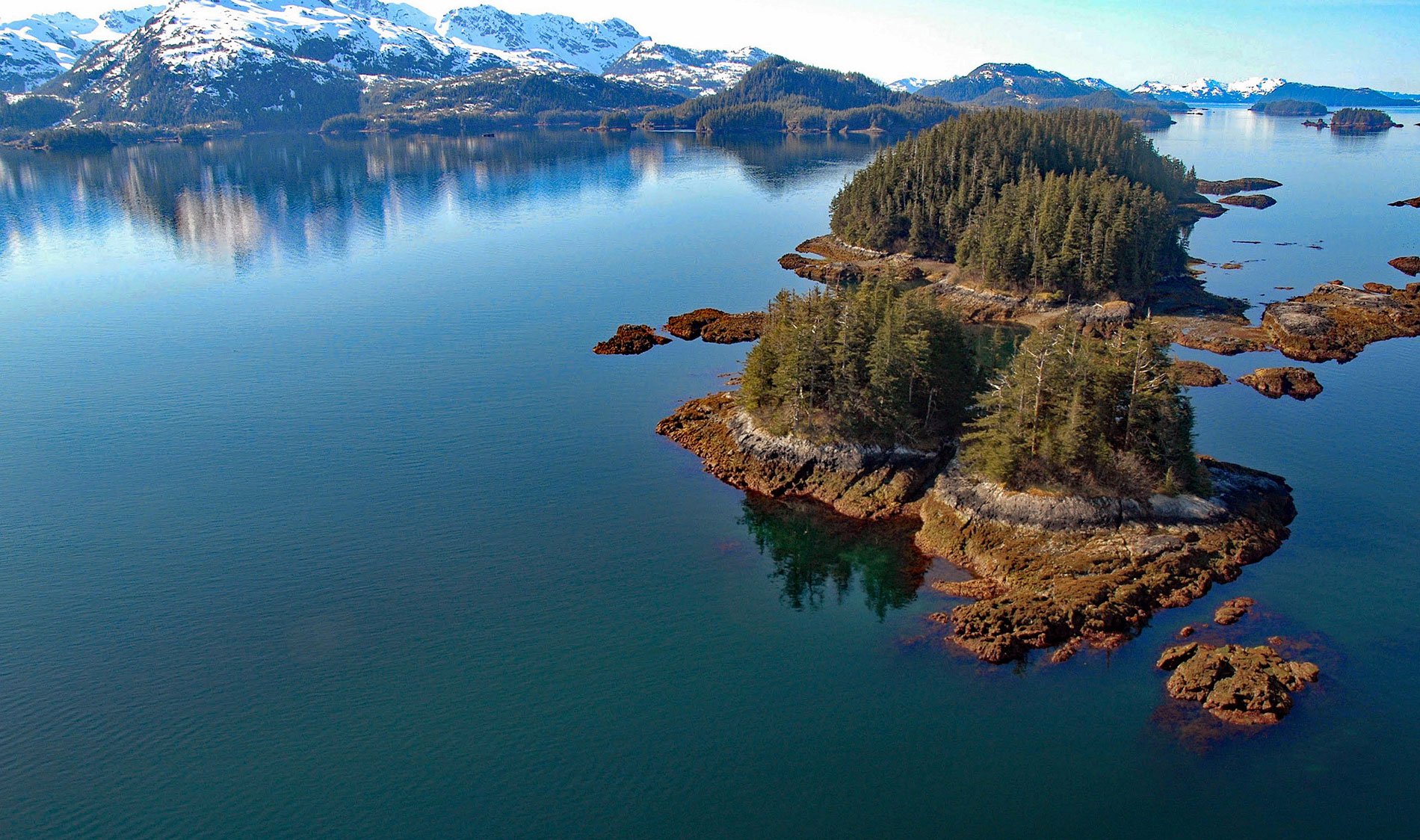New Year Islands are at the mouth of Drier Bay in Knight Island Passage on the west coast of Knight Island in Prince William Sound, about 55 miles (89 km) east-northeast of Seward and 41 miles (66 km) southeast of Whittier, Alaska. The island cluster includes eight islets and over a dozen tidal reefs. Knight Island has a land area of 68,480 acres (27,713 ha) and no resident population. The majority of the island is a part of Chugach National Forest, with private inholdings owned by Chugach Alaska Corporation and Chenega Corporation. The geology of Knight Island and the landforms created by glaciation create one of the most scenic islands in Prince William Sound. During the Last Glacial Period, an extensive ice sheet covered Prince William Sound, and glacial ice rose high up on the flanks of the surrounding Chugach Mountains. The direction of movement of this ice sheet was toward the south and southwest. Knight Island shows striking evidence of glaciation with smoothed and striated rock surfaces, hanging valleys, and steep-sided fjords. The glaciated surfaces, while smooth in detail, are very irregular, especially where the underlying rocks are greenstones, a terrane that gives rise to irregular shorelines and diversified topography. On Knight Island, which is made up mainly of these greenstones, this irregularity of shoreline is evident. Among the highest peaks on Knight Island are the Three Giants near the head of Drier Bay. The tops of these greenstone peaks, with elevations of 2,686, 2,602, and 2,830 feet above sea level, are sharp and not glaciated, but smoothing and evidence of glaciation extend to about 2,400 feet.
Prince William Sound was inhabited for thousands of years by various Indigenous Peoples including the Chugach, Ahtna, Eyak, Alutiiq, and Tlingit who traded and occasionally fought each other. In 1778, Captain James Cook entered the sound and named it Sandwich Sound, after his patron the Earl of Sandwich. Later that same year, the name was changed to honor Prince William Henry, the third son of King George III. In 1790, the Spanish explorer Salvador Fidalgo entered the sound and named many features including Port Valdez, Port Gravina, and Cordova Bay (now called Orca Inlet). In 1793, Russian fur traders with the Lebedev-Lastochkin Company, a predecessor to the Russian-American Company, built a stockade at Nuchek on Hinchinbrook Island and established a permanent trading post called Fort Saint Konstantine and a Russian Orthodox church. In 1867, the Alaska Purchase transferred the territory from Russian to the United States. In 1892, the Afognak Forest and Fish Culture Reserve, with an undetermined size, was established in Alaska by an executive order from President Grover Cleveland. In 1904, Gifford Pinchot, the chief of the forest reserves, instructed W.A. Langille to reconnoiter Prince William Sound and the Kenai Peninsula and make recommendations regarding the location of another forest reserve. In 1907, Congressional legislation was introduced to create new reserves in Southeast Alaska and in the Prince William Sound area, and the Chugach National Forest was established from a portion of the Afognak Forest Reserve, and the latter name was discontinued. Prince William Sound represents about 48 percent of the national forest, and there is very little logging done in the remainder. Less than 2 percent of the forest is considered suitable for commercial logging operations which is unusual among U.S. national forests. Instead, the Chugach National Forest generates revenue through tourism, recreation, commercial fishing, and mining.
Mineral prospecting was done on Knight Island in 1906 and 1907, and much of this was in Drier Bay. The Knights Island Consolidated Copper Company, locally known as the Hubbard-Elliott Company, built a wharf, offices, ore bunkers, and a steam power plant at the northeast corner of Drier Bay. Work was done on several claims but the main development was on two tunnels called the Monarch and the Bald Eagle. The former was 1.5 miles (2.4 km) northeast of the dock and about 600 feet (183 m) above sea level. Here some 350 feet (107 m) of tunnel work was done. The Bald Eagle tunnel was about 900 feet (274 m) above sea level and .75 mile (1.2 km) northeast of the dock. The tunnel was connected to the dock with a wire-rope aerial tramway, but this was damaged by a snow slide in the early part of 1908. The prospect of the Russell Ball Copper Company was located on the south side of Drier Bay, between Barnes Cove and Mallard Bay. The company had located six claims, four on Drier Bay and two over the ridge from Drier Bay The property on Drier Bay was developed by four tunnels with a wire-rope aerial tram operated by a windlass rigged from the upper tunnel to the shore. This tunnel was 520 feet (158 m) above sea level. Mineral outcroppings were also found higher at an altitude of about 1,000 feet (305 m), but these were usually covered by snow. In 1915, considerable open-cut work was done and 60 feet (18 m) of tunnel was driven. Both mines were closed during World War I. Read more here and here. Explore more of New Year Islands and Drier Bay here:

